
What Goes Into an Appraisal?Their home's purchase can be the largest financial decision most of us could ever consider. It doesn't matter if where you raise your family, an additional vacation property or an investment, purchasing real property is a detailed financial transaction that requires multiple people working in concert to pull it all off. Most of the parties involved are very familiar. The most recognizable person in the exchange is the real estate agent. Then, the lender provides the money required to bankroll the exchange. And ensuring all areas of the sale are completed and that the title is clear to pass from the seller to the purchaser is the title company. So, who's responsible for making sure the value of the real estate is consistent with the amount being paid? In comes the appraiser. We provide an unbiased opinion of what a buyer could expect to pay — or a seller receive — for a parcel of real estate, where both buyer and seller are informed parties. A licensed, certified, professional appraiser from Cory Chase will ensure, you as an interested party, are informed. Inspecting the subject propertyTo ascertain the true status of the property, it's our duty to first perform a thorough inspection. We must see aspects of the property hands on, such as the number of bedrooms and bathrooms, the location, and so on, to ensure they really are present and are in the shape a typical buyer would expect them to be. To make sure the stated size of the property has not been misrepresented and describe the layout of the property, the inspection often entails creating a sketch of the floorplan. Most importantly, the appraiser identifies any obvious features - or defects - that would have an impact on the value of the house. Following the inspection, we use two or three approaches to determining the value of real property: a paired sales analysis, a replacement cost calculation, and an income approach when rental properties are prevalent. 
Cost ApproachHere, we pull information on local building costs, the cost of labor and other factors to calculate how much it would cost to replace the property being appraised. This value commonly sets the upper limit on what a property would sell for. It's also the least used method. 
Paired Sales AnalysisAppraisers become very familiar with the subdivisions in which they appraise. They innately understand the value of specific features to the people of that area. Then, the appraiser looks up recent sales in the area and finds properties which are 'comparable' to the home in question. Using knowledge of the value of certain items such as upgraded appliances, extra bathrooms, additional living area, quality of construction, lot size, we add or subtract from each comparable's sales price so that they more accurately match the features of subject property.
Once all necessary adjustments have been made, the appraiser reconciles the adjusted sales prices of all the comps and then derives an opinion of what the subject could sell for. When it comes to valuing features of homes in Visalia and Tulare, Cory Chase is second to none. This approach to value is typically awarded the most weight when an appraisal is for a home sale. Valuation Using the Income ApproachA third way of valuing real estate is sometimes employed when a neighborhood has a measurable number of renter occupied properties. In this case, the amount of revenue the property generates is taken into consideration along with other rents in the area for comparable properties to derive the current value. Putting It All TogetherCombining information from all approaches, the appraiser is then ready to state an estimated market value for the property at hand. It is important to note that while the appraised value is probably the most reliable indication of what a house is worth, it may not be the final sales price. Prices can always be driven up or down by extenuating circumstances like the motivation or urgency of a seller or 'bidding wars'. But the appraised value is often employed as a guideline for lenders who don't want to loan a buyer more money than they could recover in case they had to sell the property again. It all comes down to this, an appraiser from Cory Chase will guarantee you discover the most accurate property value, so you can make profitable real estate decisions. |